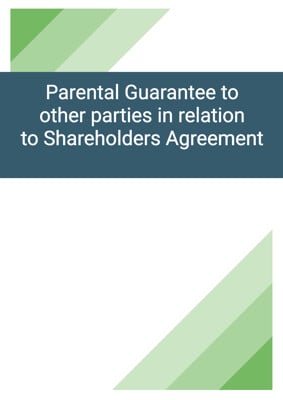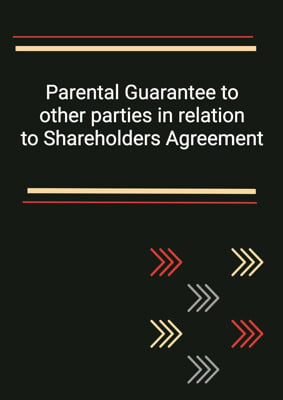How to Tailor the Document for Your Need?
01
Create Document
Fill in the details of the parties. You can click the "Fill with Member’s Information" button to complete it with information saved to your account.
02
Fill Information
Please fill in any additional information by following the step-by-step guide on the left hand side of the preview document and click the "Next" button.
03
Get Document
When you are done, click the "Get Document" button and you can download the document in Word or PDF format.
04
Review Document
Please get all parties to review the document carefully and make any final modifications to ensure that the details are correct before signing the document.
Document Preview
Document Description
This shareholders agreement is a legally binding document that governs the relations between the parties as shareholders in a jointly-owned company. The agreement highlights the importance of forming the company and acquiring certain rights and assets. It sets out the terms and conditions that will govern the shareholders' relationship and the management of the company.
The agreement begins with an interpretation section, which defines key terms used throughout the document. It provides definitions for terms such as party 1 director, party 1 shares, party 2 director, party 2 shares, and so on. These definitions ensure clarity and understanding of the terms used in the agreement.
The document then proceeds to outline the process of establishing the company. It specifies the requirements for incorporation, including the company's name, authorized share capital, and registered office. The completion of the establishment of the company is also detailed, including the subscription for shares by each party and the issuance of share certificates.
Next, the agreement addresses the capital and further finance of the company. It outlines the share capital structure and the possibility of increasing the share capital. It also establishes the procedure for providing further finance to the company, including approaching the company's own bankers and the parties' obligations regarding guarantees.
The section on directors and management covers the composition of the board of directors and the appointment and removal of directors by each party. It specifies the quorum and voting rights at board meetings, as well as the notice and agenda requirements. The decisions of the board are deemed binding, subject to the reserved shareholder matters that require the prior approval of the parties.
The agreement includes a list of reserved shareholder matters that require the parties' approval. These matters include issues such as the issuance of shares, sale of the company, alteration to the memorandum and articles, borrowing by the company, and approval of the annual budget and operating plan.
The transfer of shares section outlines the process for transferring shares between the parties. It includes provisions for transfer notices, purchase notices, determination of fair price, and the right of first refusal. The section also prohibits dealings in beneficial interest in shares, except through permitted transfers.
Confidentiality obligations are addressed in a separate section, which requires the parties to keep confidential any information acquired in relation to the company or the other party. Exceptions to the confidentiality obligation are specified, such as publicly available information or information disclosed in accordance with legal requirements.
The agreement also includes provisions regarding restrictions on the parties, term and notice, supremacy of the agreement, costs, no partnership or agency, entire agreement, assignment, conditions precedent (if applicable), amendment, no rights of third parties, and dispute resolution.
In summary, this shareholders agreement is a comprehensive document that covers all aspects of the parties' relationship as shareholders in the company. It provides detailed provisions for the establishment of the company, capital structure, management, transfer of shares, confidentiality, and other important matters. By entering into this agreement, the parties ensure clarity, protection of their rights, and the smooth operation of the company.
How to use this document?
To use this shareholders agreement effectively, follow these steps:
1. Incorporation: Ensure that the company is incorporated in accordance with the agreed characteristics outlined in the agreement. This includes choosing a name for the company, preparing the memorandum and articles, and determining the authorized share capital.
2. Completion: Complete the establishment of the company by subscribing for shares and issuing share certificates to each party. Make sure that all necessary documents, such as the asset transfer agreement, distribution agreement, technology license, intellectual property license, supply agreement, and services agreement, are entered into as specified in the agreement.
3. Capital and further finance: Understand the share capital structure and the possibility of increasing the share capital. If further finance is required, first approach the company's own bankers. If finance cannot be obtained from the company's own bankers, consider providing finance in equal proportions with the other party.
4. Directors and management: Appoint directors to the board in accordance with the agreement. Ensure that the board is constituted by directors appointed by each party. Follow the quorum and voting requirements at board meetings. Provide proper notice and agenda for board meetings.
5. Reserved shareholder matters: Obtain prior approval from the parties for any matters listed as reserved shareholder matters. This includes issues such as issuing shares, selling the company, altering the memorandum and articles, and approving the annual budget and operating plan.
6. Transfer of shares: If a party desires to sell or dispose of shares, follow the process outlined in the agreement. Serve a transfer notice to the other party, who has the right to purchase the shares at the specified price. If the other party does not exercise this right, determine the fair price with the assistance of the auditors. If no sale to a third party purchaser is concluded, consider putting the company into liquidation.
7. Confidentiality: Ensure that all parties and their employees and agents maintain confidentiality regarding any information acquired in relation to the company or the other party. Only disclose information in accordance with the exceptions specified in the agreement.
8. Compliance with restrictions: Abide by the restrictions on engaging in competing business during the term of the agreement. Avoid carrying on or being engaged in any business that competes with the company's business.
9. Term and termination: Understand the minimum term of the agreement and the notice period for termination. If either party wishes to terminate the agreement, provide the required notice in writing. Cooperate to ensure the completion of any ongoing contracts and consider putting the company into liquidation.
10. Supremacy of the agreement: Ensure that the provisions of this agreement are duly performed and that they prevail over any conflicting provisions in the memorandum and articles.
11. Costs: Bear and pay the costs associated with the incorporation of the company individually. Each party is responsible for its own costs related to the preparation and execution of this agreement.
12. No partnership or agency: Understand that this agreement does not create a partnership or agency relationship between the parties. Neither party has the authority to commit or bind the other party.
13. Entire agreement: Acknowledge that this agreement, along with any other agreements entered into on completion, constitutes the entire agreement between the parties. Any representations, warranties, or undertakings not expressly set out in this agreement are not relied upon.
14. Assignment: Do not assign this agreement or any rights or obligations under it without proper authorization. Any transfer of shares must comply with the provisions of the agreement.
15. Conditions precedent (if applicable): Ensure that all conditions precedent to the establishment of the company are fulfilled or waived before completion. Use reasonable endeavors to fulfill these conditions as soon as possible.
16. Amendment: Any variation of this agreement must be in writing and signed by or on behalf of the parties. Variations do not constitute a general waiver of any provisions and do not affect rights, obligations, or liabilities that have already accrued.
17. No rights of third parties: Understand that third parties have no right to enforce any terms of this agreement.
18. Dispute resolution: Agree to the jurisdiction clause and follow the specified procedures for giving notices and serving legal proceedings.
By following these steps, you can effectively use this shareholders agreement to govern your relations as shareholders in the company and ensure compliance with the agreed terms and conditions.
Not the right document?
Don’t worry, we have thousands of documents for you to choose from:


























